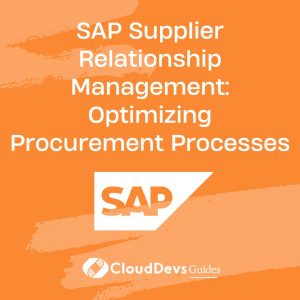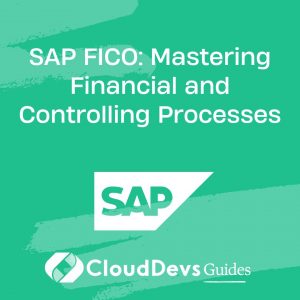SAP Supplier Relationship Management: Optimizing Procurement Processes
In today’s fast-paced business environment, efficient procurement processes are crucial for the success and competitiveness of any organization. The ability to source goods and services efficiently, manage supplier relationships, and control costs is essential. This is where SAP Supplier Relationship Management (SAP SRM) comes into play. In this comprehensive guide, we will explore how SAP SRM can revolutionize your procurement processes, from its features and benefits to implementation steps.

1. Understanding SAP Supplier Relationship Management
1.1. What is SAP SRM?
SAP SRM, short for SAP Supplier Relationship Management, is a robust procurement solution that enables organizations to streamline their procurement processes, collaborate effectively with suppliers, and optimize supplier relationships. It is part of the SAP Business Suite and is designed to help businesses enhance their purchasing efficiency, reduce procurement costs, and gain better visibility into their supply chains.
1.2. Key Features of SAP SRM
1.2.1. Procure-to-Pay (P2P) Process Automation
SAP SRM automates the entire procure-to-pay process, from requisition to invoice payment. This automation minimizes manual intervention, reduces errors, and accelerates procurement cycles.
ABAP DATA: lv_purchase_order TYPE ekko-ebeln. SELECT SINGLE ebeln INTO lv_purchase_order FROM ekko WHERE lifnr = '12345'.
1.2.2. Supplier Collaboration
SAP SRM facilitates collaboration with suppliers through a self-service portal. Suppliers can receive purchase orders, submit invoices electronically, and update their catalogs, leading to improved communication and reduced lead times.
ABAP
LOOP AT lt_supplier_list INTO ls_supplier.
WRITE: / 'Supplier Name:', ls_supplier-name,
/ 'Contact Email:', ls_supplier-email,
/ 'Phone Number:', ls_supplier-phone.
ENDLOOP.
1.2.3. Supplier Performance Management
The solution provides tools for monitoring and evaluating supplier performance, allowing organizations to identify high-performing suppliers and areas for improvement.
ABAP SELECT * FROM supplier_performance WHERE supplier_id = '12345' AND year = '2023'.
1.2.4. Spend Analysis
SAP SRM offers robust spend analysis capabilities that help organizations identify cost-saving opportunities, negotiate better contracts, and manage expenses more effectively.
ABAP SELECT * FROM spend_data WHERE category = 'Office Supplies' AND year = '2023'.
1.2.5. Contract Management
Efficient contract management ensures compliance and reduces risks. SAP SRM allows organizations to create, manage, and monitor contracts with ease.
ABAP DATA: lv_contract_number TYPE ekko-ebeln. SELECT SINGLE ebeln INTO lv_contract_number FROM ekko WHERE contract_type = 'Supply Agreement'.
2. Benefits of Implementing SAP SRM
2.1. Cost Reduction
By automating procurement processes and optimizing supplier relationships, SAP SRM helps organizations reduce operational costs.
2.2. Enhanced Supplier Collaboration
Improved collaboration with suppliers leads to faster response times, better pricing, and increased supply chain efficiency.
3. Better Decision-Making
SAP SRM provides real-time insights and analytics, enabling organizations to make data-driven decisions for procurement optimization.
2.4. Risk Mitigation
Effective contract management and supplier performance monitoring reduce risks associated with non-compliance and supplier failures.
2.5. Scalability
SAP SRM is highly scalable, making it suitable for businesses of all sizes. It can adapt to your organization’s changing needs.
3. Implementing SAP SRM
3.1. Assess Your Current Procurement Processes
Before implementing SAP SRM, it’s essential to assess your existing procurement processes thoroughly. Identify pain points, bottlenecks, and areas for improvement. This assessment will help you tailor the SAP SRM implementation to your specific needs.
3.2. Define Clear Objectives
Set clear and measurable objectives for your SAP SRM implementation. Whether it’s reducing procurement costs, improving supplier collaboration, or enhancing spend analysis, having defined goals will keep your implementation on track.
3.3. Select the Right SAP SRM Version
SAP offers various versions of SRM, including on-premises and cloud-based solutions. Choose the version that aligns best with your organization’s IT infrastructure and business requirements.
3.4. Customize and Configure
Work closely with SAP SRM consultants to customize and configure the solution to match your specific business processes. Tailoring the software to your needs is crucial for maximizing its benefits.
ABAP DATA: lv_customization_data TYPE string. lv_customization_data = 'Customize SRM UI for Buyer Role'.
3.5. Data Migration
Ensure a smooth transition by migrating relevant data from your existing procurement system to SAP SRM. This step is critical for continuity in your procurement operations.
ABAP DATA: lv_data_migration_status TYPE boolean. lv_data_migration_status = 'Data migration complete'.
3.6. Training and User Adoption
Provide comprehensive training to your procurement team and end-users to ensure they are comfortable with the new system. User adoption is key to realizing the full potential of SAP SRM.
ABAP DATA: lv_training_schedule TYPE string. lv_training_schedule = 'User training sessions from Monday to Friday'.
3.7. Testing and Quality Assurance
Thoroughly test the SAP SRM implementation to identify and resolve any issues or bugs. Quality assurance is essential for a successful launch.
ABAP DATA: lv_testing_status TYPE string. lv_testing_status = 'Testing phase in progress'.
3.8. Go-Live and Monitoring
Once you’ve completed all the necessary preparations, it’s time to go live with SAP SRM. Continuously monitor the system’s performance and gather feedback from users for further improvements.
ABAP DATA: lv_go_live_date TYPE dats. lv_go_live_date = '2023-09-30'.
Conclusion
SAP Supplier Relationship Management (SAP SRM) is a powerful tool that can revolutionize your organization’s procurement processes. With its extensive features for automation, supplier collaboration, performance management, spend analysis, and contract management, SAP SRM offers numerous benefits, including cost reduction, enhanced supplier relationships, better decision-making, risk mitigation, and scalability. Implementing SAP SRM requires careful planning and customization to align with your specific needs, but the results are well worth the effort. By following the steps outlined in this guide, you can optimize your procurement processes and stay ahead in today’s competitive business landscape.
Are you ready to transform your procurement processes with SAP SRM? Contact us today to get started on your journey to procurement excellence.
Table of Contents








